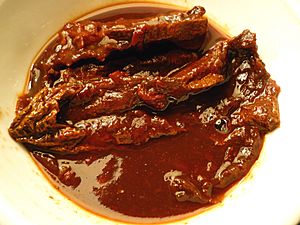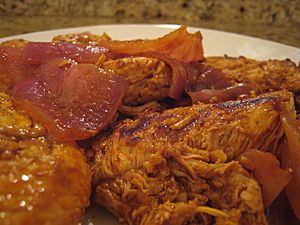Adobo facts for kids

Lomo en adobo—pork loin marinated in adobo
|
|
| Type | Sauce or marinade |
|---|---|
| Place of origin | Spain, Portugal |
| Main ingredients | Paprika, salt, garlic, and vinegar |
Adobo is a special way to prepare food. It means soaking raw food in a flavorful sauce or mix of spices. This mix often includes ingredients like paprika, oregano, salt, garlic, and vinegar. The main goal is to make the food taste amazing and also to help keep it fresh for longer.
This cooking style started in Spain and Portugal. From there, it spread to many other places. This includes countries in Latin America, and also Spanish and Portuguese colonies in Africa and Asia.
It's important to know that in the Philippines, there's a dish also called Adobo. However, it's a completely different cooking method that developed on its own. Even though it also uses vinegar, it's not the same as the Spanish or Portuguese Adobo.
Contents
What is Adobo?
Adobo is both a cooking method and the name of the special sauce or spice mix used. Think of it as a marinade that gives food a deep, rich flavor.
How Adobo Helps Food
Long ago, people needed ways to keep food from spoiling. Refrigerators didn't exist! Adobo was a great solution. Soaking meat or fish in this mix helped preserve it.
One key ingredient is paprika. This spice not only adds a reddish color but also has properties that help stop bacteria from growing. It also helps the flavors soak deep into the food.
How Adobo is Used Today
While Adobo was first used to preserve food, today it's mostly about adding incredible flavor. People use Adobo to marinate meats, fish, and even vegetables before cooking them.
Some famous dishes made with Adobo include:
- Cazón en adobo: This is dogfish (a type of shark) marinated in Adobo, popular in Cadiz, Spain.
- Berenjenas de Almagro: These are pickled aubergines from the Castile-La Mancha region of Spain.
- Lomo en adobo: This is tenderloin (like pork or beef) marinated in the Adobo mix.
Different Kinds of Adobo
The word "Adobo" can mean different things depending on where you are. Recipes for the marinade or spice mix change a lot from one region to another. When meat is marinated with Adobo, it's often called adobado or adobada.
Mexican Adobo
In Mexico, Adobo usually refers to a sauce or seasoning that uses different types of chilies. Two common ones are Chipotle and Ancho peppers. Ancho peppers are dried Poblano chilies that have turned red. These sauces add a smoky and spicy taste to food.
Chipotles in Adobo Sauce
A popular Mexican dish is chipotles en adobo. This is where chipotle peppers (which are smoked jalapeño peppers) are cooked in a sauce. The sauce often includes tomatoes, garlic, vinegar, salt, and various spices. Common spices are cumin and dried oregano. Sometimes, orange juice or lemon/lime juice is added, along with a little brown sugar to balance the flavors.
Puerto Rican Adobo
Puerto Rico has its own style of Adobo. It's a seasoned salt that people sprinkle or rub generously on meats and seafood. This is done before grilling, frying, or sautéing. You can even buy ready-made mixes in stores.
There are two main types:
- Wet Adobo (Adobo Mojado): This is a paste made from crushed garlic, olive oil, salt, black pepper, fresh or dried orégano brujo (a type of oregano), and citrus juice or vinegar.
- Dry Adobo (Adobo Seco): This is more common. It's a dry mix of garlic powder, onion powder, salt, black pepper, and dried orégano brujo. Sometimes, dried citrus zest is also added. It's easy to make and lasts a long time.
Peruvian Adobo
In Peru, especially in the Arequipa area, Adobo is a traditional dish. It's made with pork marinated in spices and vegetables. This mixture is cooked slowly in a clay pot until the pork becomes very tender. People usually eat it with bread, which is great for soaking up the delicious sauce.
Philippine Adobo
In the Philippines, "Adobo" refers to a very common cooking method that started there. When Spanish explorers arrived in the late 1500s, they saw Filipinos cooking food by stewing it with vinegar. Because it seemed similar to their own Adobo, the Spanish gave it the same name. But remember, Filipino Adobo is a completely different way of cooking and developed on its own.
Unlike the Spanish and Latin American versions, Filipino Adobo uses ingredients native to Southeast Asia. The main ingredients are vinegar, soy sauce or patis (fish sauce), black peppercorns, and bay leaves. It doesn't traditionally use chilies, paprika, oregano, or tomatoes.
There are different kinds of Filipino Adobo:
- Adobong Puti (White Adobo): This version uses salt instead of soy sauce.
- Adobong Tuyo (Dry Adobo): This means the sauce is cooked down until it's almost gone, leaving the meat coated in a rich flavor.
The dish is often made with pork or chicken. Sometimes, only vegetables like kangkong (water spinach) or sitaw (green beans) are used.
The only real similarity between Filipino Adobo and Spanish/Latin American Adobo is the use of vinegar and garlic. Filipino Adobo usually tastes salty and sour, and often a little sweet. This is different from Spanish and Mexican Adobos, which are usually spicier or have a strong oregano flavor.
Uruguayan Adobo
In Uruguay, Adobo is a spice mix that uses the same spices as the Spanish marinade. The act of using this mix to season food is also called adobar. If you mix Adobo spices with salt and water, it's called mojo.
History
One of the first times Adobo was written about was in a cookbook from 1850. It was called Manual del Cocinero, Repostero, Pastelero, Confitero Y Bottilera by Mariano de Rementeria y Fica.
Images for kids
-
Peruvian adobo chicken made from dried aji panca (yellow lantern chili, Capsicum chinense)
See also
 In Spanish: Adobo para niños
In Spanish: Adobo para niños








